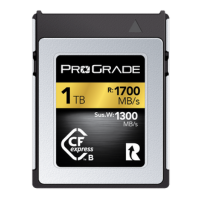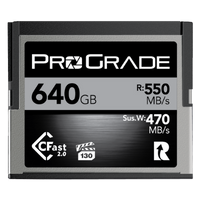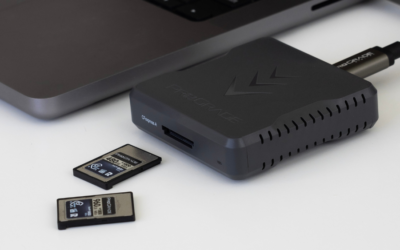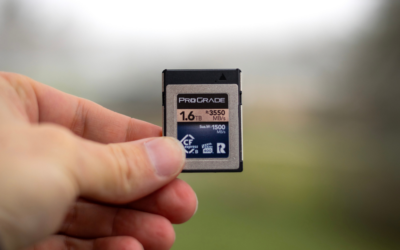Whether photographing your loved ones for a personal project or filming giraffes on a professional assignment, your data is your lifeline. It’s essential to have a reliable and efficient storage solution that meets your needs and can keep up with your workflow. With so many options available, deciding which is best for you can be overwhelming. In this article, we’ll look closer at the differences between solid-state drives (SSDs) and traditional hard disk drives (HDDs) and help you decide on the best storage solution for your photography and videography needs.
Hard Disk Drives (HDDs): Pros and Cons for Creative Professionals
For many years, traditional hard drives have been a popular storage solution for creative professionals, including photographers and videographers.
Hard disk drives, or HDDs, consist of spinning disks that rotate at high speeds. The disks are coated with a material that can be magnetized in different directions. The magnetic charges represent ones and zeros in the binary language computers use. The storing process is all about encoding the data onto the magnetic platters by changing the polarity of tiny magnetic domains on the platter’s surface. This is done by the read/write head floating on a cushion of air just above the spinning platters. When reading data, the head detects the magnetic charge of the bits passing beneath it and converts that charge back into the ones and zeros of the digital data.
One of the main advantages of HDDs is their relatively low cost per gigabyte of storage compared to other options, making them a cost-effective choice for photographers and videographers who need large amounts of storage. They are also widely available and compatible with various devices, including older computers and laptops.
On the other hand, traditional hard drives have some downsides that photographers and videographers should consider. One of the significant drawbacks is their slower performance compared to SSDs. Due to their mechanical structure, traditional hard drives have a longer data transfer time, which can be frustrating for those working on large file sizes.
Another disadvantage of traditional hard drives is their vulnerability to physical damage, especially when in use. The read/write head is fragile and can be easily damaged, which can lead to data loss. As a result, professionals need to handle traditional hard drives with utmost care and avoid moving them while in use. Also, strong magnets pose a serious risk and corrupt stored data by messing with the polarity of the tiny magnetic domains.
Solid-State Drives (SSDs): Advantages and Disadvantages in Photography and Videography
Solid-State Drives (SSDs) are a newer type of storage solution that has gained popularity in recent years. Unlike traditional hard drives, SSDs do not use spinning disks to store data magnetically. Instead, they work by storing data in microscopic compartments called flash cells, which contain floating gate transistors. Electrical charges are used to program the cells, with a charged cell representing a “1” and an uncharged cell representing a “0.” When data is read, a voltage is applied to the cell, and the resulting current is measured to determine whether the cell is charged or not.
This storing method allows us to access data stored on an SSD much faster than on traditional hard drives. However, they also have some drawbacks, including a higher cost per gigabyte.
Comparing Performance: SSD vs. HDD – Speed, Reliability, and Lifespan
1. Speed
When it comes to performance, SSDs hold a clear advantage over traditional hard drives. With no moving parts and faster data transfer speeds, SSDs can read and write data much faster than conventional hard drives. Specifically, while a standard hard drive typically reads and writes data at speeds between 80MB/s to 160MB/s, an SSD operates at speeds between 200MB/s to 550MB/s. This speed difference can significantly improve workflow efficiency, enabling you to transfer large volumes of images and sizeable video files more quickly. This is particularly beneficial when working with data in real-time. However, when it comes to long-term storage and archiving your images, it really comes down to personal preferences and budget. If you have the patience for slower data transfer, traditional hard drives may be suitable. However, if you frequently need to browse and pull images from your catalog, the speed advantages of SSDs could make them a better fit.
2. Reliability
In terms of reliability, SSDs are also superior. With no moving parts, they are less prone to damage from drops or bumps and are unaffected by magnetic fields like traditional hard drives. But, again, it doesn’t mean you should necessarily opt 100% for SSDs. If your discs are stored and used safely in your home or studio, and you take them out only every now and then, classic hard drives will work just fine. Then again, if your workflow requires you to constantly take your drives to shoots and copy data on the go, you should seriously consider SSDs. Especially when dealing with fast-paced shoots in demanding environments.
3. Last but not least: Lifespan
The limited lifespan of flash memory cells and the charge in the cells leaking away over time has been paraded all over the internet since the first SSDs were introduced. This has created a widespread belief that solid-state drives have a short lifespan and are unsuitable for long-term data storage.
True, flash memory cells have a limited lifespan, but it is by no means short. Plus, the magnetic properties of HDDs will also diminish over time.
With hefty everyday use and even with daily full read/write cycles, SSDs will last 10+ years easily. Meanwhile, most hard disk drives last only three to five years before some component fails. With all the moving parts inside, there is a higher chance that something will eventually stop working.
According to research, if a drive is error-prone, it will likely fail within the first year. In fact, statistically, every eMLC SSD drive has only a 0.09% likelihood of failure at the 6-month mark and even lower 0.023% at the 5-year mark.
At the same time, a compelling study into hard drives found that a reasonable estimate of the median life expectancy of a hard drive is six years and nine months. The HDD failure rate hovered around 1-2% for the first three years and reached as high as 13% after five years of use.
However, if removed from operation and safely stored, hard drives may last a decade (possibly even two) before magnetic properties diminish to the point of the disc becoming unreadable.
As for charge retention of SSDs, enterprise-grade SSD drives with five-year warranties or longer can also retain your data for at least 15-20 years. Some even without any power supply.
That said, connecting your SSD, commercial or enterprise-grade, to a power supply once or twice a year is still a good practice, as it recharges the cells. Contrary to widespread belief, there’s no reason to rewrite the data to renew the charge. Just power up the drive and use it for a few minutes. This is sufficient to maintain data integrity. The same goes for HDDs.
Storage Capacity: Which Option Fits Your Needs?
Storage capacity is essential when choosing a storage solution for your photography and videography needs. Traditional hard drives are available in larger sizes, up to 18TB. In comparison, SSDs are typically available in smaller sizes, up to 8TB, except for some high-capacity SSDs with astronomical price tags.
In finding the storage solution that best suits your needs, you might want to consider a hybrid approach. There’s no rule stating you have to pick one type exclusively. By integrating both SSDs and traditional hard drives, you can create a custom storage setup that leverages the strengths of each. For instance, an SSD could serve as your primary storage for images and videos you frequently access or currently post-process, while an HDD could be used for long-term storage and management of larger files.
Balancing Cost and Performance: Choosing the Right Storage Solution for Your Creative Workflow
Choosing the proper storage solution for your photography and videography needs is critical for the smooth functioning of your creative workflow. Both traditional hard drives and SSDs offer advantages and come with disadvantages, and the right choice comes down to individual needs, workflow, and budget.
If you work with large files or need faster data transfer speeds, an SSD may be the better choice, despite the higher cost per gigabyte. The same goes for the photographers and videographers constantly taking their drives to shoots. On the other hand, if you have a limited budget and need a single volume with higher storage capacity, a traditional hard drive may be the more cost-effective solution.
It’s essential to consider the performance, reliability, storage capacity, and price when selecting a storage solution. Remember that the most reliable storage solution may not always be the fastest or the most affordable, and vice versa. Ultimately, the choice comes down to your individual needs and priorities.
In Conclusion: SSDs vs. HDDs
As with any media storing essential data, quality is paramount. It is critical to keep in mind that not all SSDs and HDDs are created equal. So, it’s not just a decision of one or the other but also of choosing the right brand and model. Even though SSDs are generally superior regarding reliability, it does not mean all SSDs are. You will definitely find HDDs with better build quality than some SSDs.
Regardless of the storage solution you choose for your media, ensuring your data is backed up, protected, and recoverable should always remain your priority. In addition to selecting the appropriate storage device, it is essential to implement a well-structured file management system and a robust backup strategy. An organized file management system not only saves time and effort in the long run but also plays a critical role in preventing data loss.
From Camera to Storage: Ensure Data Integrity with ProGrade Digital Memory Cards and Card Readers
Whether you choose an SSD or traditional hard drive for your storage needs, having a reliable memory card and card reader is essential for any creative professional to make sure your images make it on the storage drive in the first place. We at ProGrade focus on quality and reliability and offer a range of high-quality memory cards and workflow readers to meet the needs of professional filmmakers and photographers.





